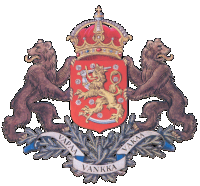Finland
From Kaiserreich
m |
|||
| Line 71: | Line 71: | ||
Cold relations with: [[Sweden]], [[Russia]], [[Commune of France]] | Cold relations with: [[Sweden]], [[Russia]], [[Commune of France]] | ||
| - | [[Category:Countries]] [[Category:European countries]] [[Category:Mitteleuropa]] | + | [[Category:Countries]] [[Category:European countries]] [[Category:Mitteleuropa]] [[Category:Monarchies]] |
Revision as of 11:27, 21 December 2008
| ||||||

| ||||||
| Official Language | Finnish | |||||
| Capital | Helsinki | |||||
| Head of State | Fredrik Kaarle I von Hesse-Kassel | |||||
| Head of Government | Vihtori Kosola | |||||
| Establishment - Declaration of Independence | 6th of December 1917 | |||||
| Government | Constitutional Monarchy | |||||
| Currency | Suomen Markka | |||||
| Motto | Vapaa, Vankka, Vakaa (Free, Firm, Stable) | |||||
| Anthem | Maamme | |||||
| Area | 361,470 sq.km | |||||
| Population | 3 612 400 | |||||
Finland is a country in northern Europe. It borders Russia, Norway and Sweden. It is mainly inhabited by Finns, but there are Sami and Swedish minorities also.
Contents |
Political System
Finland is governed by an highly authoritarian righ-wing government. The King has significant political power compared to other monarchs in the nearby regions. The Lapua movement holds all important governmental positions, and could be considered the only political party in the state.
Military
Finland counts on national conscription to form the bulk of the army. There are also many standing divisions deployed at the moment. Armoured units don't have real place in the Finnish terrain, which has huge forests and thousands of lakes. The airforce is non-existent, but the Navy has great value to the Lapua movement, which has great aspirations to rule the Baltic. Still, Finland is a small nation and its military has many limits. Finland can wage land war quite succesfully, but the other aspects of warfare need to be improved heavily.
History
Finland gained her independence during the general collapse Russian Empire in 1917, and the country fought a brief, but bitter civil war soon after between the Reds, formed from various leftists activists, and the Whites, made up by conservative-nationalist opposition and the official government. In the end the White forces won with the help of German support, and Finland became a monarchy under the rule of prince Frederick of Hesse, who assumed the name Fredrik Kaarle I. After the civil war nationalist activism remained very strong, and various Finnish activist groups participated in so-called "Tribe Wars" from the United Baltic Duchy to Petsamo in the north, with the goal of creating a united Greater Finland. When the East Karelian national revolt of 1921 threatened to escalate into a full-scale war the Germans forced a peace between Finland and Russia and the Treaty of Tartu signed later that year established a compromise, giving Finland Petsamo but placing Karelia out of their reach. The treaty also forced Sweden to concede control of the Aland Islands, an act of coercion that has created much bad blood between the Central Powers and Sweden.
Finland had now reached a new height of expansion, but many were still dissatisfied. Rumours of a massacre of Karelians in Russia, worldwide anti-democracy sentiments and strong national activism served as the catalysts that gave birth to the Lapua Movement, which started as an anti-leftist organization but quickly developed much more ambitious aims. In 1932 the Lapua Movement gathered its forces and started a revolt in Mantsala. Enjoying widespread support, most importantly from voluntary defence organizations, the Movement clearly presented a threat to the existing order. In response to this threat, Fredrik Kaarle I decided that it would be best to join with the movement rather than fight it, doing so by dismissing the parliament and requesting that the Lapua Movement to form a new government.
Foreign Relations
Friendly relations with: Germany, United Baltic Duchy, Ukraine
Cold relations with: Sweden, Russia, Commune of France


